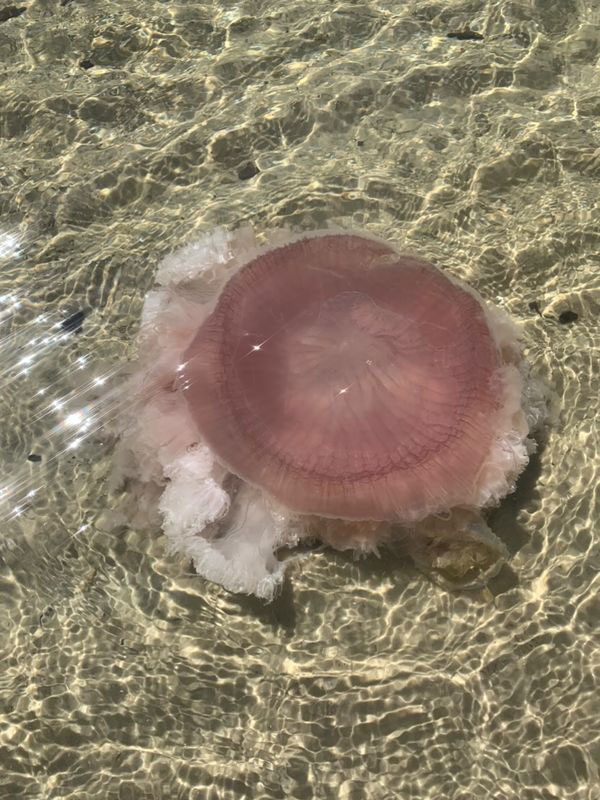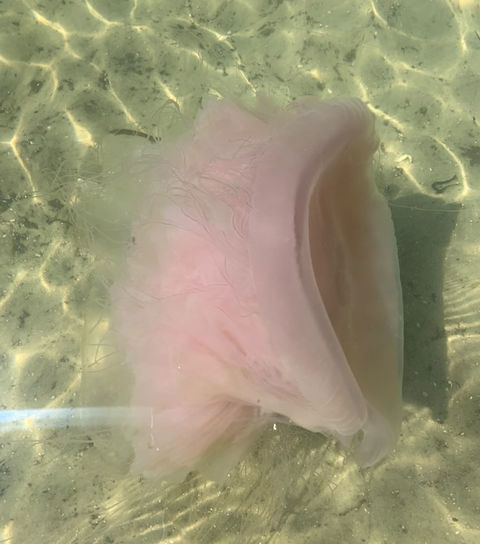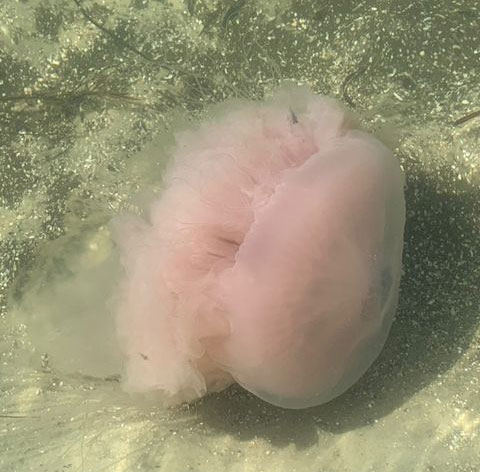(October 05, 2022) --

A pink blob floating in the waters off of Alabama is catching people's attention as they walk along the beach. Several of DISL's followers have even messaged to find out more.
The pink blob is known as a pink meanie. The scientific name is Drymonema larsoni, and was named by former DISL post-doctoral student Keith Bayha. He has continued some of his jellyfish work as a Research Collaborator at the Smithsonian Institute National Museum of Natural History in the lab of Dr. Allen Collins.
Bayha offered a bit of a back story on how naming the jellyfish came to pass.
“Pink meanies first started showing up in the northern Gulf of Mexico in the early 2000s and were recorded by Monty Graham at DISL,” Bayha said. “Dr. Graham sent me samples for DNA analysis when I was a graduate student at the University of Delaware. I tried to use them for a study I was doing on the Lion’s Mane Jellyfish, whose family the pink meanie previously belonged to, but they were too different.”
Bayha worked at DISL from 2004 until 2007 but never saw a pink meanie during that time. Then, when he was at the University of California Merced, he did an evolutionary study of the True Jellyfish (Scyphozoa). This study included sea nettles, lion’s mane jellyfish, and moon jellyfish. His study included specimens of the Gulf of Mexico pink meanie and Drymonema from the coast of Turkey.

“In that study, it became clear that Drymonema was a brand new family and very distinct from the Lion’s Mane Jellyfish,” Bayha said.
Bayha used DNA sequencing, morphology, and habitat information to determine the pink meanie was a new species and family. In a 2010 publication, Bayha and Michael Dawson described the Dymonema as a new family and the Gulf of Mexico pink meanies as a new species. He named the new species Drymonema larsoni after Ron Larson.
“Larson was a colleague and all-around great person who used to collect specimens for the Smithsonian Museum of Natural History and did research on the pink meanie in the Caribbean in the 1970s and 1980s,” Bayha explained. “We also named the Family Drymonematidae, amending the work done by Ernst Haeckel, contemporary of Charles Darwin and famous for his jellyfish illustrations.”
Bayha adds that naming the pink meanie after Larson was one of his memorable moments as a scientist, and Ron was extremely humble and thankful. The pink meanie was also featured on the front page of the Mobile Register in 2010 in an article by Ben Raines.

Pink Meanie Facts
Bayha explains that as adults, pink meanies only eat other jellyfish with a preference for moon jellyfish. As such, they really only bloom in the late summer/early fall when there are large moon jellyfish populations. They only live as long as their prey is plentiful, and will die when it gets cold.
When pink meanies are very small they eat zooplankton just like other jellyfish but their bodies grow to support a jellyfish-only diet.
With their large bell, lots of baby fish will use the area underneath the bell as shelter.
The pink meanie can get very large and a sting by multiple tentacles could be painful. However, Bayha said, based on his experience the sting is not terrible.
"I had my arm up to the elbow in a really large one we had collected and the sting was minor. My entire arm had a rash the next day, but it wasn’t bad at the time. They eat jellyfish so don’t need stinging cells full of toxins."
In the bigger picture, the pink meanies are beneficial because they eat jellyfish that may otherwise impact local zooplankton populations such as shellfish and fish larvae.
Bayha said that in 2010 while he was at the Dauphin Island Sea Lab and in Dr. Graham’s lab again, they collected multiple Drymonema and kept them in tanks. That meant also keeping a lot of moon jellyfish in tanks.